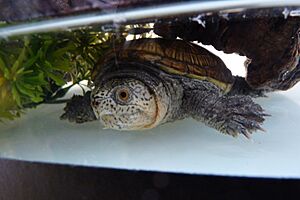Narrow-bridged musk turtle facts for kids
The narrow-bridged musk turtle (Claudius angustatus) is a special kind of turtle. It belongs to a group of turtles called the Kinosternidae family. You can find these turtles in parts of Central America and Mexico.
Quick facts for kids Narrow-bridged musk turtle |
|
|---|---|
 |
|
| Claudius angustatus in an aquarium |
|
| Conservation status | |
| Scientific classification | |
| Genus: |
Claudius
|
| Species: |
angustatus
|
| Synonyms | |
|
|
Contents
Where Narrow-Bridged Musk Turtles Live
You can find the narrow-bridged musk turtle in Mexico, Guatemala, and Belize. These countries are all located in Central America.
About the Narrow-Bridged Musk Turtle
What They Look Like
The narrow-bridged musk turtle is usually brown. Its carapace (the top part of its shell) has special lines and patterns. These patterns make the shell look a bit like wood. Sometimes, you might see bright yellow spots on the edges of their shell.
As these turtles get older, algae (a type of plant-like growth) often grows on their shells. This can cover up their cool patterns and colors.
Head and Jaw
This turtle has a large, rounded head for its body size. It also has a sharp beak and a long neck. The way its jaw connects is very special. Most turtles have a jaw joint that is shaped like two cups fitting together. But the narrow-bridged musk turtle's jaw joint is more like a ball and socket. This is quite unusual for modern turtles.
Shell Shape and Size
The top shell, or carapace, is dome-shaped. It has three clear ridges running along its length. Even though it's related to "giant" musk turtles, the narrow-bridged musk turtle is not very big. Its shell usually grows to about 6.5 inches (16.5 cm) long.
How They Determine Sex
Unlike most turtles, the sex of a narrow-bridged musk turtle is decided by its genes. This is called genetic sex determination. For many turtles, the temperature of the nest decides if a baby turtle will be male or female. Scientists think this turtle might use an XX/XY system, similar to its relative, the Staurotypus turtle.
Behavior, Habitat, and Diet
Where They Live and What They Do
Like all musk turtles, the narrow-bridged musk turtle spends almost all its time in water. They like places with slow-moving water, like creeks, or shallow ponds that have lots of plants. They often walk along the bottom of the water.
What They Eat
These turtles search for food on the bottom of the water. They eat aquatic insects and other small creatures without backbones, called invertebrates. They also eat carrion, which is dead animals.
Why They Are Called "Musk" Turtles
The narrow-bridged musk turtle has special glands under the back of its shell. If they feel threatened, they can release a stinky, musky smell from these glands. This is how they got their common name.


